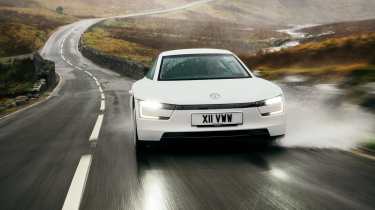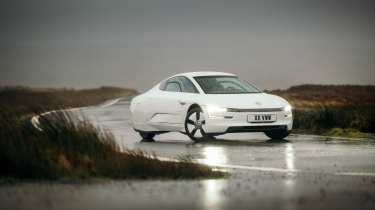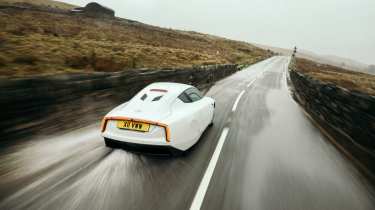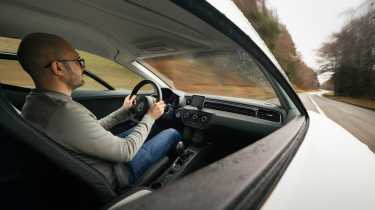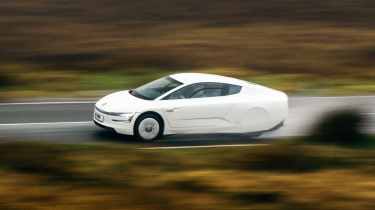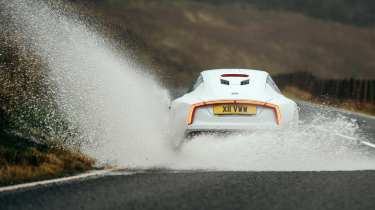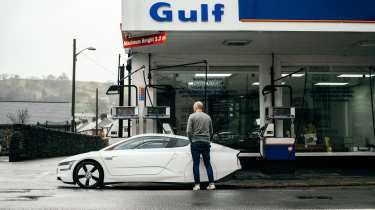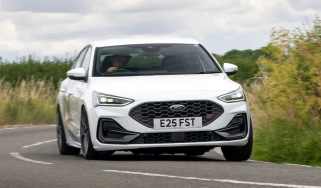Volkswagen XL1 (2013) review – Bugatti-level engineering aimed at MPG not MPH
Another hair-brained Piëch passion project, the XL1 is shot through with hypercar engineering, all to an end of saving fuel
Pity the Volkswagen XL1. Designed to slow the worrisome pace of climate change and the extreme weather events brought with it, and here we are driving it right into the eye of a wintry storm. The idea was a noble one: setting an urban-centric eco-car free into the Welsh wilderness to truly explore the potential of its surprisingly promising mechanical makeup.
The reality is it’s being buffeted around by 50mph gusts while its weeny tyres – just 115mm wide up front – slice through frequent standing water. Its single wiper is working overtime. Snapper Aston Parrott resembles a recently overboard trawlerman every time he emerges from this familiar stretch of Snowdonia scenery, yet he’s grinning even more than normal. It turns out VW’s endearing little weirdo is just as bewitching to photograph as it is to drive.
With a carbonfibre tub, mid-mounted engine and rear-wheel drive, it’s not far off being a miniature McLaren. And that’s before you’ve swung open a diminutive butterfly door and nestled low into an interior rich with more carbon weave and with a broad windscreen affording an enticing view of the road ahead. I’d swear it even smells the same as a Woking-born supercar…
The spec sheet brings me back to earth with a thump. This is what plug-in hybrids resembled before they morphed into SUVs limboing under company car tax barriers, mating a 47bhp, 89lb ft 800cc two-cylinder diesel engine – effectively VW’s ubiquitous 1.6-litre TDI sliced in half – to a 27bhp, 103lb ft electric motor and 5.5kWh battery, which charges from a socket or tops up via brake regen.
More reviews
Engine and motor never fully combine, though; instead the peak whole-system outputs are 68bhp and 103lb ft. Top speed is electronically limited to 99mph (the car’s ultra-slippery 0.186 Cd profile can enable more) and the contemporary brochure proudly claimed that ‘if necessary, the XL1 can accelerate to 62mph in just 12.7 seconds’. Kinda says it all.
> Volkswagen Passat 2025 review – a breath of fresh air next to leaden EVs
Yet it weighs just 795kg thanks to truly fastidious – indeed, supercar-worthy – engineering. Nearly a quarter of the car is carbonfibre, most prominently its monocoque and exterior panels, the latter wearing paint that’s 50 per cent lighter than the norm. The side windows are polycarbonate and only partially open via a pair of sweet little manual winders, which sit just inches away from the hi-res displays of its cameras-for-mirrors. As a quick window into the XL1’s sometimes paradoxical soul, it’s perfect.
Volkswagen XL1 price and history
Launched in 2013, a limited run of 250 cars were sold, around a tenth of which came to the UK wearing their wheel on left and a £98,515 price tag. Completely gobsmacking for a People’s Car with under 70bhp, yet it feels safe to assume each one sold at a loss.
This was VW with its chest puffed and shoulders broad, the whole project spun from a Ferdinand Piëch target for a ‘1-litre car’ – one capable of travelling 100km on a single litre of fuel. Piëch drove an initial concept car to a shareholder meeting in 2002 to prove his intention. By 2009 it had evolved into something much more beguiling, the Volkswagen 1L concept previewing a diesel hybrid powertrain but with tandem seating to keep it ultra-narrow.
Just two years later jaws dropped as it was unveiled in road-legal form. Renamed XL1, its seats were now two abreast and its footprint similar to that of a Polo. ‘With a small, flexible development team, short communication lines and quick decisions we were able to achieve our development goals within almost half the standard development time,’ remembers project leader Hannes Spalink.
‘To set a benchmark on not just one, but four main pillars of a vehicle – design, aerodynamics, powertrain and weight – was extraordinary,’ adds the XL1’s exterior design lead, Peter Wouda. ‘It was an outrageous project, probably once in a lifetime.’ Production began in 2013 in the former Karmann factory in Osnabrück, the limited run of XL1s basically hand built while Boxsters and Caymans entered final assembly around them. Osnabrück now makes the T-Roc Cabriolet. How times change…
Much like the Bugatti Veyron, this was a Piëch project that surpassed its target. By production, the XL1 achieved 0.9l/100km – or 313mpg – while carbon emissions were just 21g/km. We see similar numbers from much plumper PHEVs now, but in VW’s slippery little eco-cigar they feel at least in the same county as ‘achievable’, if not postcode. A combined range of 600 miles is theoretically possible, but today we’ll barely breach 100 before both elements of its powertrain are crying out for a top-up, most urgently its 10-litre diesel tank. Oops.
Aston and I aren’t the only ones with a mischievous side, though. There’s word the car hit 125mph in testing but I can’t begin to imagine the length of run-up that was needed (or how strong the tailwind was). While the XL1 feels quicker off the line than its spec sheet suggests, it begins to run out of puff not far north of the B4391’s limit. Driving it quickly is truly a game of maintaining as much momentum as possible.
> BMW Z1 (1989 – 1991) review – there's more to BMW's first Z car than its famous gimmick
The passion poured into the XL1 is evident the moment you first set eyes on it – in our case when it rolled, in hushed tones, from the back of a transporter looking not unlike one of Gerry Anderson’s wackier devices disgorging from the pod of Thunderbird 2. Its mixture of technological intrigue and sheer cuteness is irresistible, yet it’s a serious device, too. There’s double wishbone suspension up front, carbonfibre anti-roll bars and carbon-ceramic brakes. Those are tucked behind magnesium wheels wrapped in low rolling resistance tyres sized 115/80 R15 front, 145/55 R16 rear. Another window into the XL1’s soul… or more specifically its grip limits.
Driving the Volkswagen XL1
You won’t be surprised to learn you’ll sense understeer first in harder cornering, but you soon learn to trust the grip is there – even in these conditions – and begin to work with it, the non-assisted steering brim-full of feel. The sheer effort it requires when parking feels as surprising as the manual windows, but just like those it saves weight while serving up a committed vibe. Dinky urban cars usually have head-scrambling turning circles; the XL1 does not.
The feeling of a McLaren tribute act returns in quite notable kickback through the steering during mid-corner bumps, too. In fact the XL1’s ride is rather rigid and there’s not huge breadth to its suspension travel, evidenced when the road narrows and you start nudging loudly into the catseyes. Yep, it’s easy to think the XL1 is narrower than it actually is on occasion. But the fact it’s not swamped (literally or figuratively) by this road proves its mettle.
The sheeting rain is a great leveller, bringing its modest limits more starkly to life while also showing what a pain in the arse a full-scale supercar would be. If we’d arrived in a 765LT it might have worn out its traction control fuse by elevenses, whereas the XL1 encourages me to really push its chassis and explore every last bit of its modest grip and performance.
That’s not to say its own safety systems don’t occasionally interrupt over particularly sodden crests, and they can’t be loosened. Intrinsic balance ensures it’s not an issue, however, and I’m soon braking hard into bends to throw weight over the skinny front tyres so I can get back on the throttle and juuuust feel the driven rear axle pivot round, the steering relaying everything.
Its brakes take plenty of acclimatisation, a mixture of their in-built regenerative abilities and carbon-ceramic composition making the first inches of pedal travel a little aloof. And for all its decent pace on the flat, you really have to plan ahead as these valley roads climb.
There’s no option for manual control for its standard seven-speed DSG transmission and its mapping is unfailingly eco minded, changing up at around 4000rpm and holding a gear or two higher than you’d like in any given corner. But these are all mere quirks to adapt to; wrap your head around its unique needs and desires and the XL1 rewards and utterly charms you in its own way. Typically well within the national speed limit, too.
It’s hard not to wonder what another 100bhp – at least – would do to elevate the driving experience to something truly thrilling. Perhaps a modern-day successor, with the rich and instant torque of a full EV, would answer the call neatly. But it would be a different car. The XL1 grabs your heartstrings because of the technological cul-de-sac it occupies.
It’s the very epitome of engineers flexing their muscle and asking ‘what if’ with little fear of the consequences. The fact its layout is an anomaly rather than a premonition feels a crying shame. I’m not sure there’s another VW imbued with such abundant character without a GTI badge. Even then I’d argue only the pioneering Mk1, deft Mk5 and majestic Clubsport S are truly on par.
The XL1 possesses everything we love about cars, just with starkly lower limits and less familiar sensations. What a privilege it is to let one loose on roads like this, where we can all safely wager they never usually go. But it’s thrived. You’d embarrass hypercars by taking one to the local Cars ‘n’ Coffee, but I urge you to pick up a takeaway latte and head further afield. All it craves is more power from a more vivid, higher-revving powertrain.
Which it so very nearly got. A year into XL1 production, Volkswagen unveiled the XL Sport concept using the V-twin of the Ducati 1199 Superleggera. It weighed more, at 890kg, but a 197bhp peak (at over 11,000rpm!) helped halve the 0-62 time while upping the top speed to 168mph. Would a bike engine carrying five times the weight feel wildly exciting or uncommonly hard work?
Either way, swapping the world’s most economical twin for its most powerful was a very evo kind of engine swap, and all with dynamic upgrades to ensure it worked: forged wishbones at each corner, a longer wheelbase, an electrically deployed spoiler and 265mm rear tyres on 18-inch wheels.
The 200 millionth car to wear a VW badge (apparently – it’s certainly a neat marketing line) had a sense of fun bubbling throughout, most visible in a wooden gear selector referencing the Porsche 917 from the other end of Piëch’s career. ‘I had the chance to drive the XL Sport once on our Ehra-Lessien test track,’ Wouda reminisces. ‘And with a bit of snow on the tarmac. I had tears in my eyes – tears of joy!’
The XL Sport’s – and indeed our – misfortune was that it was unveiled in late 2014, with the looming cloud of Dieselgate about to change VW’s outlook completely. Numerous projects were euthanised as headlines and lawsuits stacked up, a mightily successful WRC programme included.
Perhaps there’s some irony in Volkswagen’s eco passion project overlapping with such an infamous chapter of its history, both with diesel power at their core. Rather than snigger, though, we should be sad. You only really consider the XL1 ‘a diesel car’ when you’re triple checking you’re definitely using the correct pump to fuel a car that looks more forward-thinking as the years pass.
I spend a princely £15 brimming its tank as we leave Snowdonia to end the shoot in the XL1’s comfort zone: the urban sprawl of inner Birmingham. Besides plenty of road roar and a lack of cruise control, it sits neatly on the M54. It ought to feel as overawed as a Caterham as you dice with lorries, but you never forget you’re the star attraction, constantly given a wide berth as passengers whip out phones to film the peculiar spaceship they’ve encountered.
You only feel vulnerable when the crosswinds whip across the face of HGVs after another hard-won overtake, the most dramatic disadvantage of a lightweight streamliner. More settled motorway pace also sees our mpg quickly climb (from a low of 50mpg among the hills) as EV mode flexes its muscles with calmer throttle inputs. The dinky diesel engine drops away smoothly downhill and off-throttle but kicks back in with a touch more vigour, providing the muted sensation of a diesel generator being startled into life in next door’s garden.
There’s further proof of the XL1’s curious place in history as Aston props up his lights and tripod and I set about exploring the low-emission charge we’ve passed numerous signs for; his brand-new 193g/km Skoda is exempt, my near-decade-old 21g/km XL1 is not. But an £8 fee will be trifling to anyone who’s besotted with the idea of adding VW’s charming little experiment to their burgeoning collection.
Current values sit at around £75,000, serving up a ratio of over £1000 per horsepower. But then you’ll pay a similar rate for that other single-minded project from the big Group mothership – the one with the Bugatti badge. Would the XL1 be more valuable if it had been sold as an Audi or Porsche? It’s not too hard to imagine it as a more blockbuster debut for road-going e‑trons, its powertrain so reflective of the four-ringed diesel-hybrids sweeping up Le Mans trophies as XL1 production began.
‘Over the long term, other Group brands will also benefit from the numerous innovations implemented in the XL1,’ Volkswagen said at the time, but its influence has been drip-fed and its overall design remains unique. This may not immediately resemble an evo icon, but it’s permeated with the attention to detail we love and is adorably offbeat. It deserves the accolade.
Volkswagen XL1 specs
| Engine | 2-cyl diesel, 800cc, plus 20kW electric motor |
|---|---|
| Power | 68bhp |
| Torque | 103lb ft |
| Weight | 795kg (87bhp/ton) |
| 0-62mph | 12.7sec |
| Top speed | 99mph |
| Price new | £98,515 (2013) |
| Value today | £70,000 |
